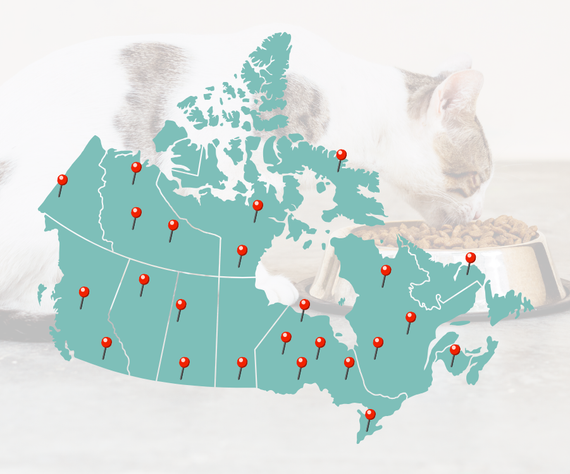News and Reports
Coercive Control Legislation Missing Critical Animal Abuse Link
Legislation currently working its way through Parliament is looking to criminalize coercive control in Canada.
But it risks doing so without capturing the full scope of the potential crime.
A private member’s bill, C-332, was introduced by NDP MP Laurel Collins earlier this year. If passed, it will amend the Criminal Code to create an offence for controlling or coercive conduct that has a significant impact on the person towards whom the conduct is directed.
Those impacts include a fear of violence, a decline in their physical or mental health, or a substantial adverse effect on their day-to-day activities.
However, the bill makes no mention of animals, despite the fact aggressors use animal abuse — and threats of it — to coerce, control, and intimidate women, children, and elders into staying silent about their abuse, preventing them from leaving or forcing them to return.
Kerri Thomson Acting Manager, Humane Canada’s CJSR Program There’s a direct correlation between animal abuse and perpetrators of intimate partner violence (IPV) or family violence, using animal abuse to coerce their victims into doing what they want,
“Animals are pawns as much as they are victims in an abusive household.”
But despite what they endure, Thomson says they aren’t viewed as victims in the eyes of the law.
“Animals are left out of these conversations when it comes to legislation in Canada because they’re considered pieces of property.”
Dr. Amy Fitzgerald is a professor of criminology at the University of Windsor whose research focuses on the co-occurrence of animal abuse and domestic violence. She says treating animals as property makes them a great tool for abusers.
“They know the chances of getting in trouble for threatening or even abusing an animal are minimal. There’s obviously not as much attention given to it, especially when the witnesses are scared to death to report it.”
Fitzgerald says some also hold the view that if you’re worrying about the animal component of a violent situation you’re not devoting enough time to the human side of things.
“And yet it’s so interconnected, you can’t disentangle the two,” she says.
“While I think the proposed legislation is a step in the right direction because coercive control is so problematic, without the animal component, it really does leave a gaping hole.”
When it comes to their companion animals, 95% of Canadians consider them family. Women, who statistics show are more vulnerable to intimate partner victimization, are often isolated from others in their lives by their abuser, so their animals are not only family, they’re also the only source of comfort and emotional support they have left.
That leaves animals vulnerable in a violent home, given an abuser’s ability to exploit their bond with the victim. Because of this, many women with companion animals will delay seeking help to escape a violent situation.
Even the threat of violence towards a companion animal holds power. It’s a common coercive, controlling tactic used by perpetrators to incite fear and gain compliance.
In a survey of women in 16 domestic violence shelters across Canada by Fitzgerald and her colleagues, 89% of survivors with animals reported their abusive partners had perpetrated at least one form of animal maltreatment, including emotional abuse, threats of harm, and neglect, such as confining the pet for a prolonged period of time or taking them away. The research found survivors clearly recognized this as an intentional move by their abuser, motivated by a desire to upset and control them.
What’s more, 68% of women said animal abuse factored heavily into their decision to leave, while 56% were reluctant to leave — and delayed doing so — out of concern for their animal’s safety.
“Unfortunately, there are likely many people who will never leave the abuser because they are so adept at threatening and using the pets as a tool of coercive control,” Fitzgerald says.
With the rise in pet ownership during the pandemic, 60% of Canadian households now have at least one cat or dog. More companion animals mean coercive control is only going to become a bigger problem, she says.
“It’s definitely an issue that isn’t going away.”
And while animals were not included in Bill C-332, during the legislation’s second reading on November 9, Bloc Québécois MP Andréanne Larouche, who is also a member of The Standing Committee on the Status of Women, made reference in her speech to the fact pets are also threatened through coercive control conduct.
Humane Canada is actively working to have animals included in this legislative conversation, including language that addresses animal sexual assault. Thomson says perpetrators often coerce their partners into engaging in bestiality and record it to use that as a tool to keep them from leaving or reporting abuse.
As sponsor, Collins says she is open to amendments that strengthen the legislation. However, given the Liberal’s support of it, Thomson is hopeful that Justice Canada will pick it up as a government bill.
That said, not everyone thinks legislation is the right route to address coercive control.
Pamela Cross, a feminist lawyer and expert on violence against women, says only about 30% of survivors of intimate partner violence turn to the criminal law when they are subjected to abuse.
“So it’s not as though by creating a new law we’re suddenly going to eradicate the problem,” she says.
“Coupled with that is the fact that the criminal law response to gender-based violence historically has been very poor. If we look at things like mandatory charging policies, and the way those have ended up backfiring on the victims they were intended to protect, I have to admit that my opinion about criminal law is a little bit jaded.”
Cross says coercive control is a very nuanced offense, a pattern of behavior over time — psychological abuse, financial control and social isolation — which is really hard for anybody outside the relationship to see and identify.
“Everybody is lacking in the knowledge that they need to deal with these cases properly, not just in criminal courts, but in family courts as well. That is a huge piece of the puzzle,” she says.
“Even if we were to end up deciding that criminalization was a good idea, we’re doing this in the wrong order.”
Cross says there needs to be investment in infrastructure to ensure women have access to information so they understand that what’s happening to them is wrong and know where to reach out for support and safety. In addition to public awareness campaigns, that investment needs to go towards educating professionals in the field who are dealing with these issues.
“Then maybe we could talk about criminalization,” she says.
Thomson doesn’t disagree. She says legislation can potentially serve as another tool in the abuser’s toolbox, used against their victim to make it appear as though they’re trying to coercively control their abuser. That’s why any legislation has to be carefully worded.
“Unfortunately, I think legislation is the only thing that people will respond to,” Thomson says. “Do I think it’s the cure all? Absolutely not.”
There also must be ongoing training for all stakeholders in the justice system so they know what coercive control looks like and how legislation can be abused.
Says Thomson: “I think that will be key.”






